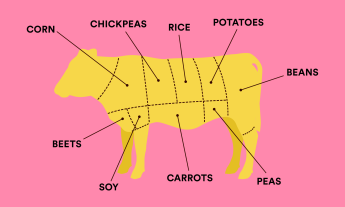
Cultured meat could be coming to our plates in the next few years. How is it made? And will it help, or hurt, the planet? Here’s what we know.
One day — maybe not that long from now — you might be able to go to the store and buy hamburger meat that didn’t require killing an animal or pretending that soybeans taste like beef. It will look like ground meat, fry up like it, and will, in fact, be just like real beef — right down to the cellular level.
The key difference? It was grown in a production facility, and not raised in the form of a living, breathing cow.
Scientists have been culturing meat in laboratories for a couple of decades, but lately, the field of companies has grown and they’re aggressively developing commercially viable products. “My latest count is there are 15 companies that have announced they’re working on so-called clean meat,” says Jacy Reese, research director at Sentience Institute, a think tank that focuses on strategies to increase concern for farmed animals (TEDxUniversityofMississippi talk: The End of Animal Farming).
Their timelines range from the wildly optimistic (the end of 2018, for JUST and Future Meat Technologies) to the more earthbound (2021, for Memphis Meats and Mosa Meat). But before you start sending out e-vites for your own cultured meat BBQ, these projections are for commercial sales — to places like bulk food sellers — and not to consumers. Still, it would be a big step.
How do you make meat in a lab? It’s not easy. First, starter cells are collected from animals via swab or biopsy. Second, the extracted cells are cultured and grown. “It’s achieved in something like a stirred tank that’s akin to beer brewing,” explains Liz Specht, senior scientist at the Good Food Institute, a think tank for the plant-based and clean meat, egg and dairy fields (to watch a TEDxSonomaCounty talk from the Institute’s executive director, go here). “You feed the cells while they proliferate exponentially.” This “feed” is full of nutrients, sugars and salts. Quite often, it contains fetal bovine serum (FBS), which comes from cow fetuses. Many consumers will balk at anything raised on FBS, and it’s also incredibly expensive, so most of the companies are focused on creating vegan serums. Third, after the cells reach a certain size, they’re placed on a porous scaffolding material — a 3D, sponge-like mesh — that can stretch to help develop the fibers that we associate with meat. There, the cells mature into small strips of meat. How small? It’s reported to take up to 20,000 strips to make one burger, according to the American Oil Chemists Society. We’ll most likely first see cultured meat in the form of ground meat, sausage or nuggets. Meat that comes in specific cuts or pieces — like a skirt steak or a chicken breast — is further off, since it requires growing different cell types and fusing them together.
The primary obstacle keeping cultured meat from your dinner plate: cost. The biggest expense in this process is the solution needed to feed the cells. “Researchers need to find an inexpensive combination of energy, nutrients and growth factors — the molecular signals that tell cells to replicate — that will encourage substantial growth,” says Reece. “FBS is so expensive there’s no way it will be the method for meat production at scale.” Israel-based Future Meat Technologies has made the bold prediction that it will be able to produce meat at roughly $4 per pound by the end of 2018 — and it says it’s using a plant-based solution — but Reece suggests that is about as realistic as pulling a drumstick out of a test tube. “Any price estimates should be taken with buckets of salt, because there’s so much uncertainty,” he cautions.
Cultured meat has several advantages over conventionally farmed creatures. (Beyond the fact that no animal — as long as the solution is vegan — will need to be killed to make it.) One biggie: Much of the meat sold today is raised on factory farms, where animals are fed antibiotics to keep them disease-free; lab-grown meat presumably won’t need drugs. It could also be free of the bacterial and chemical contaminants that can get picked up during slaughtering and packaging. For foodies, cultured meat may offer the opportunity to create products with an ideal flavor. In the future, says Specht, “culinary experts could work with producers to identify the nutrient composition and method of production that gives the sensory and quality aspects that consumers want.” Meat could be cultured to taste just like grass-fed Kobe beef or grain-fed Texas rib-eye.
But could it save the planet? We don’t know. Scientists view animal farming as the cause of many environmental problems, including global warming, pollution, deforestation and drought. The alternate scenario of a few cows standing around getting swabbed now and then certainly seems better. But what will it take to feed people’s appetite for cultured meat? What will the factories be like? What kind of footprint will they have? Two reports looked at the matter; researchers in 2011 hypothesized it would take less land, water and energy and generate fewer greenhouse-gas emissions to make the equivalent amount of cultured meat rather than raising animals, while researchers in 2015 found lab-grown meat would require less land and water but more energy. These assessments were based on extrapolations, since a large-scale cultured meat factory doesn’t exist — yet. The subject is full of unknowns. It’s been assumed that products will offer the same nutrition as conventional meat, since their products are made of meat cells. But no outside group has examined cultured meat to verify this. Interestingly, even though companies are rushing to market, at least in the US it’s still not known who will oversee clean meat: the US Department of Agriculture (which monitors meat, poultry and most egg products) or the Food and Drug Administration (which usually monitors bioengineering products).
The biggest unknown with cultured meat: will people eat it? The potential market could be huge. Global meat consumption averages 94.8 pounds per person a year, and that amount is expected to rise as much as 76 percent by 2050. In carnivorous countries like Australia and the US, the average person eats between 220 and 240 pounds of meat and poultry a year. In 2016, 673 American consumers were surveyed on the subject: 65 percent said they’d definitely or probably try it, although even those willing expressed doubts about whether it would replace farmed meat in the diets or how much more they’d be willing to pay for it. A 2013 Dutch focus group found that the more people learned about it, the more open they were to it.
The battle for the bellies of meat-eaters may depend on its name. Proponents and manufacturers favor the term “clean meat”– instead of “lab-grown meat,” “in vitro meat” or “cultured meat.” “Consumers have an aversion to new food technology, so they might avoid ‘lab-grown meat,’” Reece says. “I prefer the term ‘clean meat,’ to keep the focus on the ethical and food safety implications. In the long run, though, I think this product will simply be called ‘meat’, because that’s what it is.” More likely, the debate could be won or lost by something less fussy than semantics — namely, does it taste good? “At least four companies have done public tastings,” says Specht, who is a clean meat partisan and advocate. “People raved about it.” On the other hand, a TED colleague once tried a cultured beef burger; when asked about the flavor, he shuddered and shook his head.
Ultimately, Reece believes practicality will prevail. “I do think most people will recognize the moral demand for clean meat, especially due to concern for animals and the urgency of climate change,” he says. But he believes that even if you have less optimism than he does about humanity’s motivations, as long as clean meat is more efficient than breeding and killing animals for food, we may stop animal farming out of our own self-interest.
Watch Jacy Reese’s TEDxUniversityofMississippi talk here:















